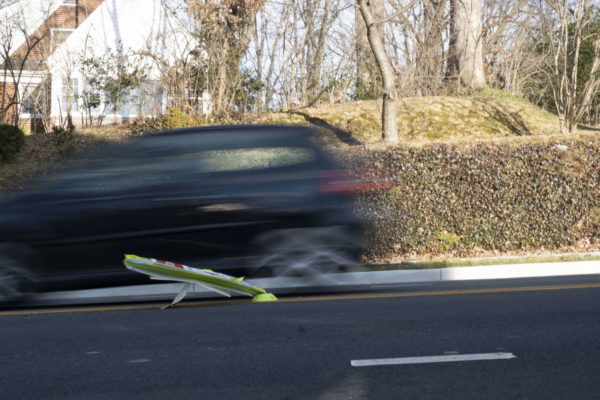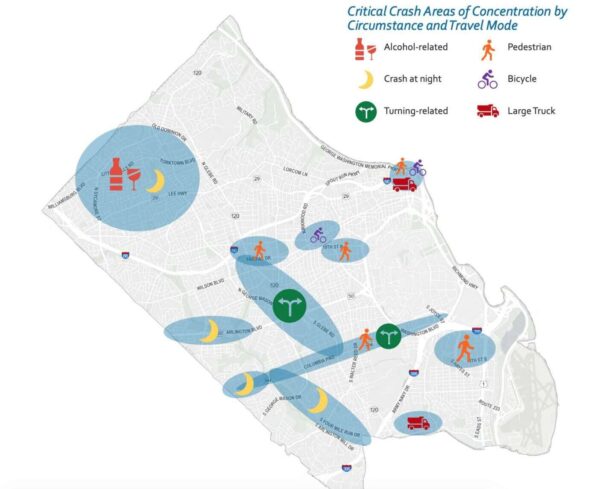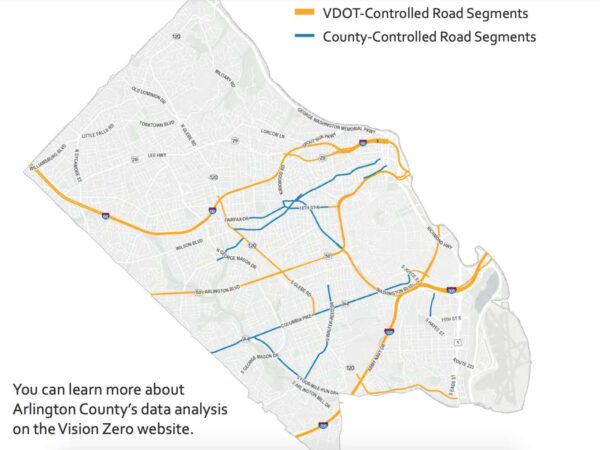By 2030, Arlington County aims to have zero transportation-related deaths and serious injuries on its streets and trails.
The County Board took its first step toward this ambitious goal in July 2019, the same year that Arlington registered six fatal crashes, according to county data. The board adopted a “Vision Zero” resolution that, at the time, offered few details. Its second step was to draft a five-year action plan.
After more than a year of work by county staff and review by advisory commissions, the final draft of the first five-year Vision Zero Action Plan, with those long-awaited details, is set to be reviewed by the County Board next Saturday (May 15).
This plan — informed by local crash data, public engagement and talks with other Vision Zero communities — lays out one-time and ongoing projects aimed at improving public safety. These range from installing automated traffic enforcement cameras and lowering speed limits to maintaining a crash data dashboard and educating children about safety with help from Arlington Public Schools.
If adopted, the plan will result in a number of changes locals will see and experience, Principal Planner Christine Baker told the Arlington Transportation Commission in February.
She said these will include enhanced intersections (shown below) and improved warning signs, as well as more education programs and messaging from the Arlington County Police Department.
 “It’ll take time to see these improvements on every single street in the county, but in the meantime, we’re going to be reporting our progress on the program,” Baker said. “We’re really excited to be diving into this program.”
“It’ll take time to see these improvements on every single street in the county, but in the meantime, we’re going to be reporting our progress on the program,” Baker said. “We’re really excited to be diving into this program.”
The county will update its website and send emailed updates telling people “when they’ll be able to recognize Vision Zero is on the streets,” she said.
Folks may be seeing some recent changes made in the spirit of Vision Zero: Over the last year, the county has sought lower speed limits while raising fines along 11 mostly residential streets in Arlington.
The County Board also made installing speed cameras a legislative priority in the 2021 General Assembly assembly session, a move toward more equitable law enforcement that also would reduce public interactions with police officers.
According to the action plan, there are a dozen target areas to tackle, from pedestrian safety and intersections to drunk or distracted driving and speeding.
Pedestrian safety is the most at risk, according to county data. One-quarter of serious crashes and more than half of fatal crashes involved a pedestrian, though pedestrian-involved crashes account for 5% of total crashes. Bicyclists and motorcycles comprise 2% and 1%, respectively.
The plan also cites data indicating that speeding and turning-related crashes are more common than alcohol-related ones, but almost half of all fatal crashes involved alcohol and more than half occurred at night.
As indicated in the graphic below, most nighttime, alcohol-related incidents occurred in the northern part of the county, while the bulk of bike- and pedestrian-involved crashes occurred along the Rosslyn-Ballston corridor and in the Pentagon City and Crystal City areas.
Staff also mapped out and intend to target Arlington’s “high-injury network,” shown below.
While the county has 555 miles of roadway, 78% of all serious or fatal crashes are concentrated within 7% of the road network. To boot, much of the county’s diverse and low-income communities live near this network, putting them in harm’s way more often.
The document has changed a few times this spring in response to feedback from the Transportation Commission. Early on, members said they worried it was not concrete enough.
During the February meeting, Chairman Chris Slatt said he was disappointed “in how vague and un-action-y this action plan is,” adding that the majority of actions were conducting more studies.
Member Chris Yarie said he wanted the document to tie action items to root causes, such as the way Arlington’s streets are designed.
“Without that explicit problem description, we could go through and check of these actions and not really solve the actual problems at hand,” he said.
Baker responded that the document tries to avoid being over-prescriptive, as that could hinder staff from addressing real problems.
“We didn’t want to corner ourselves by saying we’re going to do very specific things,” she said. “We’re creating a structure where we can be flexible and agile and work to address the most severe crashes in our most vulnerable communities first.”
Staff did edit the document to make the action items clearer and to place them front and center, Baker later told the commission, which was supportive of the changes.
“I continue to have minor concerns about tracking progress, but I think it’s come a long way,” Slatt said last month. “The most important thing we can let you guys do is to get started.”
Images via Arlington County




